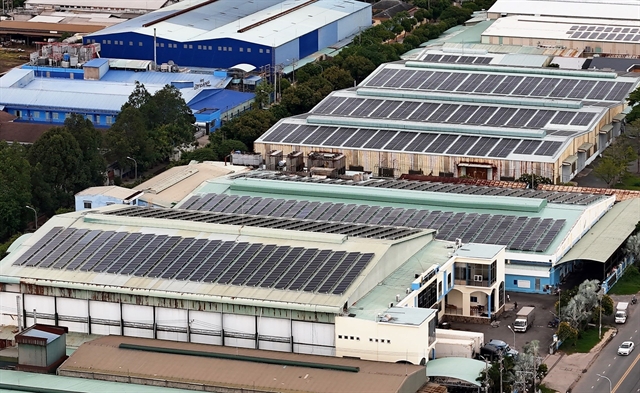Green energy development in IPs brings chances and challenges for enterprises
Development of rooftop solar in industrial parks (IPs) presents great opportunities and also challenges for businesses and investors, according to experts at a forum on promoting green energy within IPs held on May 15.

HÀ NỘI — Development of rooftop solar in industrial parks (IPs) presents great opportunities, but also challenges, for businesses and investors, according to experts at a forum on promoting green energy within IPs on May 15.
Rooftop solar energy is not only feasible, but it aligns with the national energy transition strategy, urging synchronised policy support to boost adoption, Nguyễn Ngọc Trung, deputy head of the Department of Industry under the Party Central Committee's Economic Commission, said at the forum, which was hosted by the Việt Nam Chamber of Commerce and Industry (VCCI).
Việt Nam now has more than 380 industrial parks and around 700 industrial clusters - most of which are high-energy-consumption zones.
According to Trung, the technical potential for rooftop solar power in these parks ranges from 12 to 20 gigawatt-peak (GWP) - equivalent to the output of over ten coal-fired power plants.
Unlike traditional power infrastructure, rooftop solar does not require additional land or large-scale construction. Industrial businesses can tap into unused roof space to install solar panels, aligning with the distributed energy model that the government actively promotes.
The benefits are multifaceted, including the obvious cost savings on electricity, enhanced brand reputation for environmental responsibility and reduced pressure on the national grid during peak hours.
Most importantly, the model supports Việt Nam’s COP26 commitments by cutting greenhouse gas emissions, effectively balancing economic growth with sustainability.
Việt Nam has made significant policy strides in recent years to steer its energy system toward a cleaner future.
Key documents such as the Politburo's Resolution 55/2020, the National Energy Development Strategy to 2045, and the Power Development Plan VIII, have laid the groundwork for energy transformation.
Power Plan VIII, in particular, sets ambitious targets. By 2030, 50 per cent of households and office buildings should have rooftop solar systems. Renewable energy is expected to comprise 25–30 per cent of national capacity by 2030 and rise to 74–75 per cent by 2050.
Two recently issued decrees are pivotal to this effort. Decree 57/2025/NĐ-CP introduces a direct power purchase agreement (DPPA) framework between renewable energy producers and large consumers, while Decree 58/2025/NĐ-CP offers investment incentives, including land rent exemptions, support for energy storage and promotion of technology transfer.
Addressing barriers
However, Trung pointed out that upfront investment costs remain high, a particularly heavy burden for small and medium-sized enterprises (SMEs), who constitute a large group in the industrial parks.
Technical infrastructure is also lagging in many industrial zones, lacking the metering equipment and grid readiness needed to accommodate distributed solar systems. Moreover, awareness and technical expertise among businesses remain limited.
To unlock rooftop solar’s full potential, Trung recommended expedited issuance of guidelines for new regulations, financial incentives such as tax cuts, green loans and fast asset depreciation. The ESCO model, which is a third-party investment in the system and leases back electricity, is also a solution that needs to be strongly promoted.
He also stressed the need for infrastructure upgrades such as smart metering and enhanced grid integration, and called for robust training programmes to improve renewable energy system management.
Public-private partnerships and international cooperation will be vital to secure funding through ODA, concessional loans and private capital, according to Trung.

The vice chairman of the Việt Nam Textile and Apparel Association, Trương Văn Cẩm, highlighted that 93 per cent of businesses in the sector are SMEs, many of which struggle to access capital for clean energy projects. He advocated for tax incentives and greater support in workforce training.
The General Secretary of the Việt Nam Association of Seafood Exporters and Producers (VASEP), Nguyễn Hoài Nam, emphasised that rooftop solar is crucial for the seafood sector, where freezing systems consume vast amounts of electricity.
He noted that green energy use also improves competitiveness in global supply chains, where sustainability is increasingly prioritised.
The chairman and CEO of Damsan JSC, Vũ Huy Đông, told the forum about his experience as a manufacturer involved in the full rooftop solar supply chain - from design and installation through to system operation.
Dong cited high interest rates at 7.5–8 per cent and the cautious mentality from banks as barriers to scaling-up investment.
He called for policy mechanisms to support domestic solar panel production, aiming at reducing dependence on imports.
In addition, the competent authorities should consider developing a mechanism to certify “green energy-using enterprises” to create a competitive advantage in exports, he said.
They should also allow the application of the direct power purchase agreement (DPPA) mechanisms between solar power producers and factories in industrial parks.
He called for making industrial parks with high solar energy usage a priority in investment support policies, including land allocation and investment expansion licensing.
The director of business development and partnerships at Constant Energy, Trần Thủy Tiên, said that the company has proposed various renewable solutions and rooftop solar remains the only viable model under current regulations. However, this model only meets about 20 per cent of a typical manufacturing plant’s electricity needs.
She emphasised the urgent need for clear guidelines on implementing the direct power purchase agreement (DPPA) mechanism, which allows energy transactions without going through EVN.
The company is waiting for these guidelines to start supplying businesses with clean energy directly from solar and wind farms. That will ensure that one hundred per cent of the manufacturers' green energy demands are met, Tiên said. — VNS





